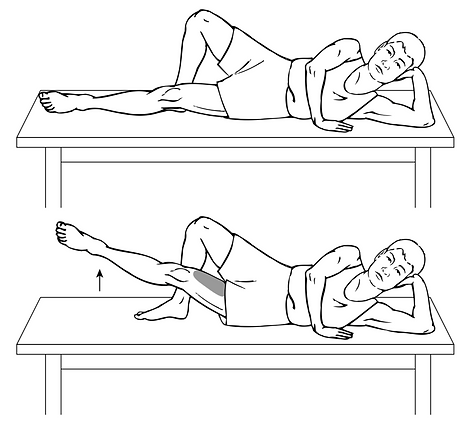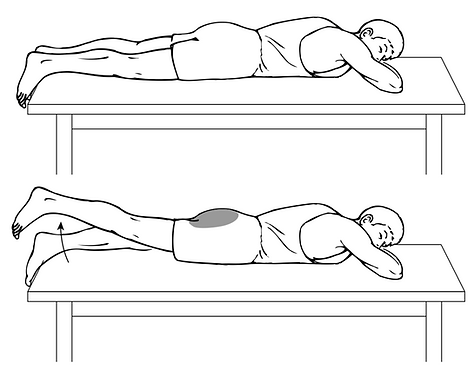Patellar Tendon Tear or Disruption
■ ■ ■ Description
Patellar tendon tear or disruption is a complete rupture of the patellar tendon. This structure is the tendon attachment of the quadriceps (thigh) muscles to the leg. The quadriceps muscles becomes a tendon above the kneecap (patella), and the tendon attaches into the patella; then another tendon goes from the patella to the tibial tubercle (the bump on the upper part of the lower leg). There is loss of continuity between the quadriceps muscles and the leg bone and thus loss of function of the quadriceps muscles when trying to straighten the knee. The function of the quadriceps muscles is to forcefully straighten the knee or slow the knee during bending or squatting. There is pressure on the patellar tendon with quadriceps contraction and with the knee bent.
■ ■ ■ Common Signs and Symptoms
-
A pop or rip felt at the knee or under the kneecap (patella) at the time of injury
-
Pain, tenderness, swelling, warmth, or redness over and around the patellar tendon
-
Pain when trying to forcefully straighten the knee or bend the knee
-
Inability to straighten the knee when seated
-
Crepitation (a crackling sound) when the tendon is moved or touched
-
Bruising at the patellar tendon and knee after 48 hours
-
Loss of firm fullness when pushing on the area where the tendon ruptured (a defect between the ends of the tendon where they separated from each other)
■ ■ ■ Causes
-
Direct blow or injury to the knee
-
Sudden episode of stressful overactivity, such as with jumping, hurdling, or starting a sprint
■ ■ ■ Risk Increases With
-
Sports that require sudden, explosive muscle contraction, such as those involving jumping and quick starts; also with running or contact sports
-
Poor physical conditioning (strength and flexibility)
-
Previous patellar tendon injury
-
Untreated patellar tendinitis
-
Cortisone injection into the patellar tendon
■ ■ ■ Preventive Measures
-
Allow time for adequate rest and recovery between practices and competition.
-
Appropriately warm up and stretch before practice or competition.
-
Maintain appropriate conditioning:
-
Cardiovascular fitness
-
Knee and thigh strength
-
Flexibility and endurance
-
-
Taping, protective strapping, or an adhesive bandage may be recommended before practice or competition.
■ ■ ■ Expected Outcome
This condition is usually curable with appropriate treatment. Sports may usually be resumed after 6 to 9 months.
■ ■ ■ Possible Complications
-
Weakness of the quadriceps muscles, especially if untreated
-
Rerupture of the tendon after treatment
-
Prolonged disability
-
Risks of surgery, including infection, injury to nerves (numbness, weakness, or paralysis), bleeding, knee stiffness, knee weakness, pain when sitting for long periods, pain when getting up from a seated position and when kneeling or squatting, pain going up or down stairs or hills, and knee giving way or buckling
■ ■ ■ General Treatment Considerations
Initial treatment consists of not walking on the affected leg, icing the area, applying a compressive elastic bandage, and elevating the injured leg to eye level. Definitive treatment requires surgery to repair the tendon. Quadriceps muscle contraction prevents the tendon ends from healing to each other without surgery. Thus there is no role for nonsurgical treatment. Surgical treatment usually involves sewing the ends of the tendon back together, followed by immobilization in a long leg cast or brace for varying periods. After surgery and immobilization, physical therapy is usually needed to regain knee motion and strength.
■ ■ ■ Medication
-
Nonsteroidal anti-inflammatory medications, such as aspirin and ibuprofen (do not take within 7 days before surgery), or other minor pain relievers, such as acetaminophen, are often recommended. Take these as directed by your physician. Contact your physician immediately if any bleeding, stomach upset, or signs of an allergic reaction occur.
-
Pain relievers may be prescribed as necessary by your physician. Use only as directed and only as much as you need.
■ ■ ■ Cold Therapy
-
Cold is used to relieve pain and reduce inflammation. Cold should be applied for 10 to 15 minutes every 2 to 3 hours for inflammation and pain. Use ice packs or ice massage.
■ ■ ■ Notify Our Office If
-
Pain increases despite treatment
-
Cast discomfort develops
-
Any of the following occur after surgery: signs of infection, including fever, increased pain, swelling, redness, drainage, or bleeding in the surgical area
-
New, unexplained symptoms develop (drugs used in treatment may produce side effects)

➢RANGE OF MOTION AND STRETCHING EXERCISES • Patellar Tendon Tear/Disruption
These are some of the initial exercises you may start your rehabilitation program with until you see your physician, physical therapist, or athletic trainer again. You will be progressed to other exercises as your condition improves. Please remember:
-
Flexible tissue is more tolerant of the stresses placed on it during activities.
-
Each stretch should be held for 20 to 30 seconds.
-
A gentle stretching sensation should be felt.
RANGE OF MOTION • Knee Flexion
-
Lie on your back with your legs out straight.
-
Slowly slide your heel toward your buttocks. Bend your knee as far as is comfortable to get a stretching sensation.
-
Hold for seconds.
-
Return your leg to the starting position.
-
Repeat exercise times, times per day.


RANGE OF MOTION • Knee Flexion and Extension
-
Sit on the edge of a table or chair.
-
Use the uninjured/unaffected leg to straighten (extend) and
bend (flex) the injured/affected leg.
-
Flexion—Cross your ankles, placing the uninjured or
unaffected leg on top of the injured/affected leg. Pull your heel(s) backward under the surface you are sitting on to increase the amount you can bend your knee.
-
Extension—Cross your ankles, placing the uninjured or unaffected leg under the injured/affected leg. Pull your heel(s) backward under the surface you are sitting on to increase the how much you can straighten your knee.
-
Repeat exercise times, times per day.
➢STRENGTHENING EXERCISES • Patellar Tendon Tear/Disruption
These are some of the initial exercises you may start your rehabilitation program with until you see your physician, physical therapist, or athletic trainer again or until your symptoms are resolved. Please remember:
-
Strong muscles with good endurance tolerate stress better.
-
Do the exercises as initially prescribed by your physician, physical therapist, or athletic trainer. Progress slowly with each exercise, gradually increasing the number of repetitions and weight used under their guidance.
STRENGTH • Quadriceps, Isometrics
-
Lie flat or sit with your leg straight.
-
Tighten the muscle in the front of your thigh as much as you can, pushing the back of your knee flat against the floor. This will pull your kneecap up your thigh, toward your hip.
-
Hold the muscle tight for _____ seconds.
-
Repeat this exercise _____ times, ______ times per day.


STRENGTH • Quadriceps, 7 Count
The quality of the muscle contraction in this exercise is what counts the most, not just the ability to lift your leg!
-
Tighten the muscle in front of your thigh as much as you
can, pushing the back of your knee flat against the floor.
-
Tighten this muscle harder.
-
Lift your leg/heel 4 to 6 inches off the floor.
-
Tighten this muscle harder again.
-
Lower your leg/heel back to the floor. Keep the muscle in
front of your thigh as tight as possible.
-
Tighten this muscle harder again.
-
Relax.
-
Repeat exercise times, times per day.
STRENGTH • Hip Adduction
-
Lie on your side as shown with the injured/weak leg on the bottom.
-
Place the foot of your top leg flat on the floor for balance. It may be in front or behind the bottom leg.
-
Lift the bottom leg as shown. Hold this position for seconds.
-
Slowly lower your leg to the starting position.
-
Repeat exercise times, times per day.


STRENGTH • Hip Extension
-
Lie on your stomach with your legs straight out behind you.
-
Raise your leg up behind you from your hip. Keep your knee straight. Hold this position for seconds.
-
Slowly lower your leg to the starting position.
-
Repeat exercise times, times per day.

STRENGTH • Hip Abduction
-
Lie on your side as shown with the injured/weak leg on top.
-
Bend the bottom knee slightly for balance. Roll your top hip slightly forward.
-
Lift your top leg straight up, leading with your heel. Do not let it come forward. Hold this position for seconds.
-
Slowly lower your leg to the starting position.
-
Repeat exercise times, times per day.
View as PDF